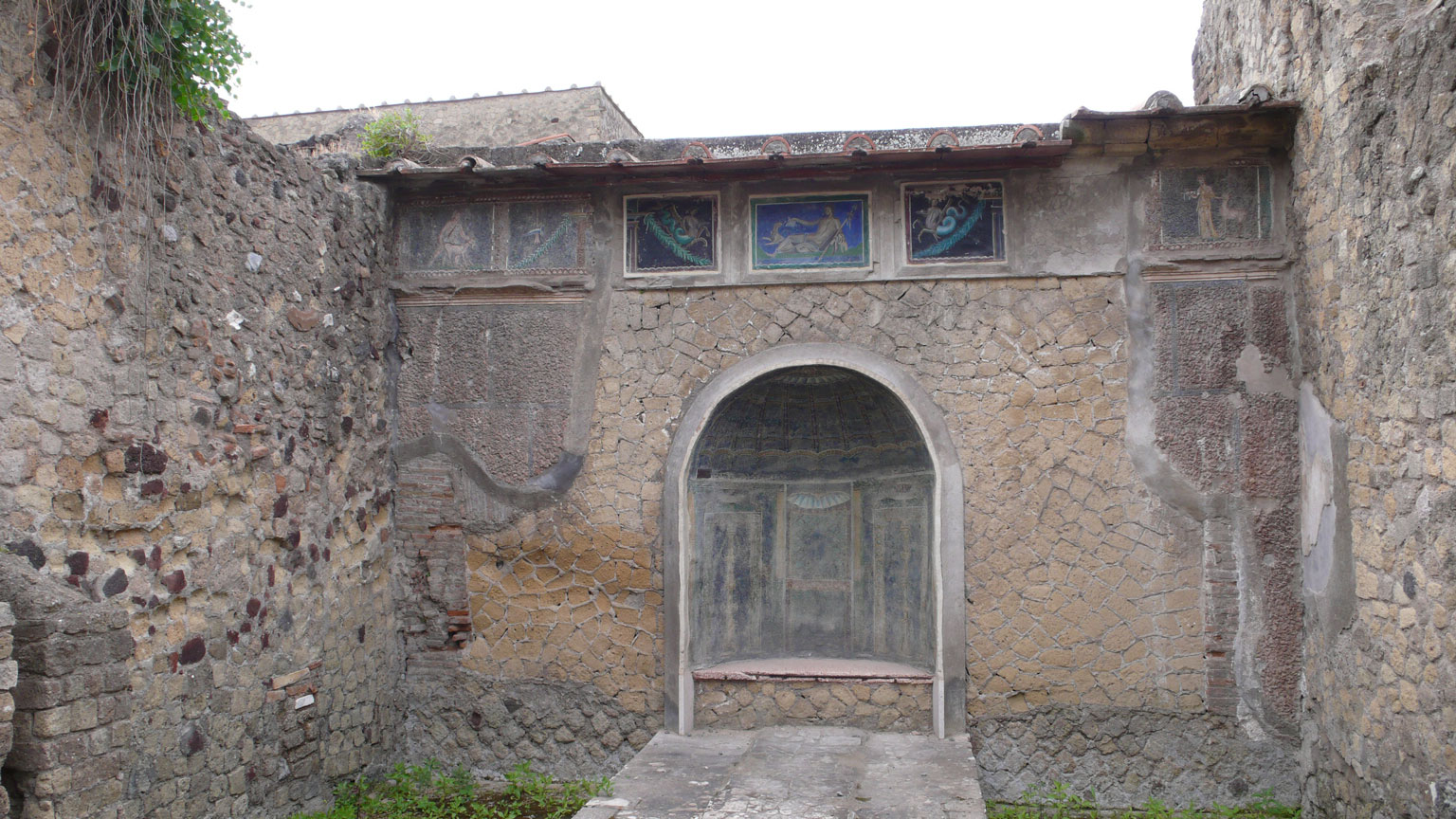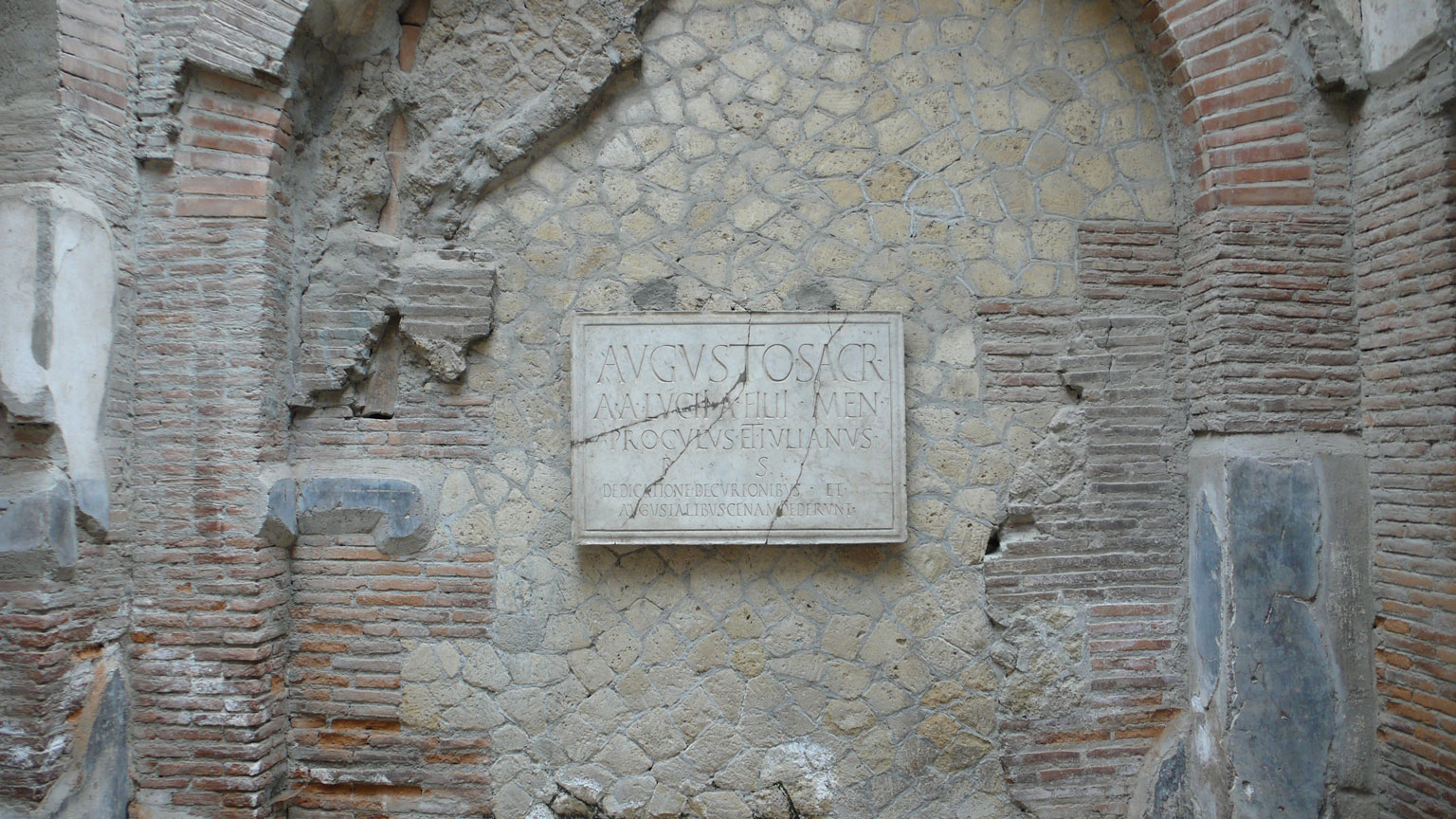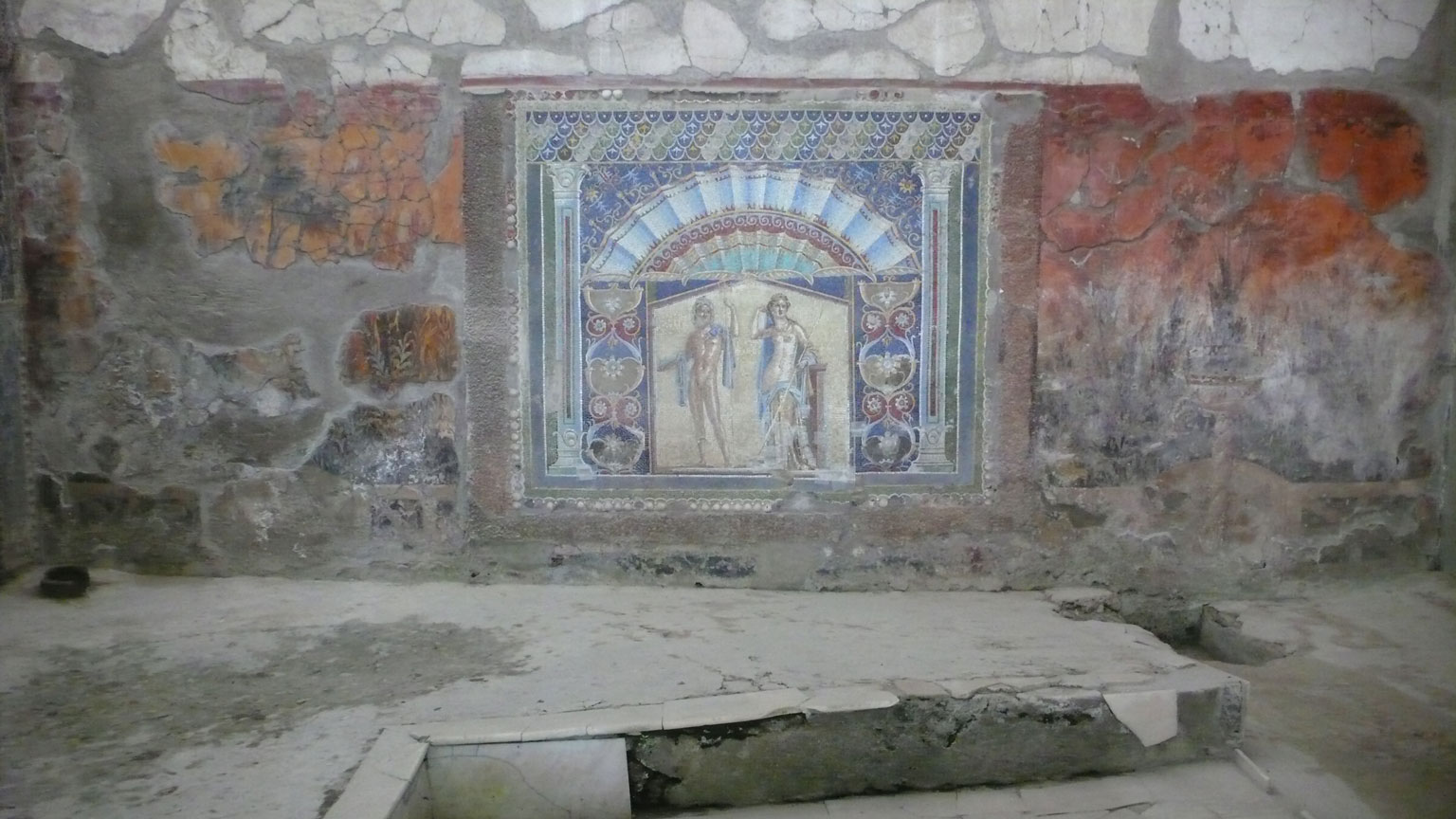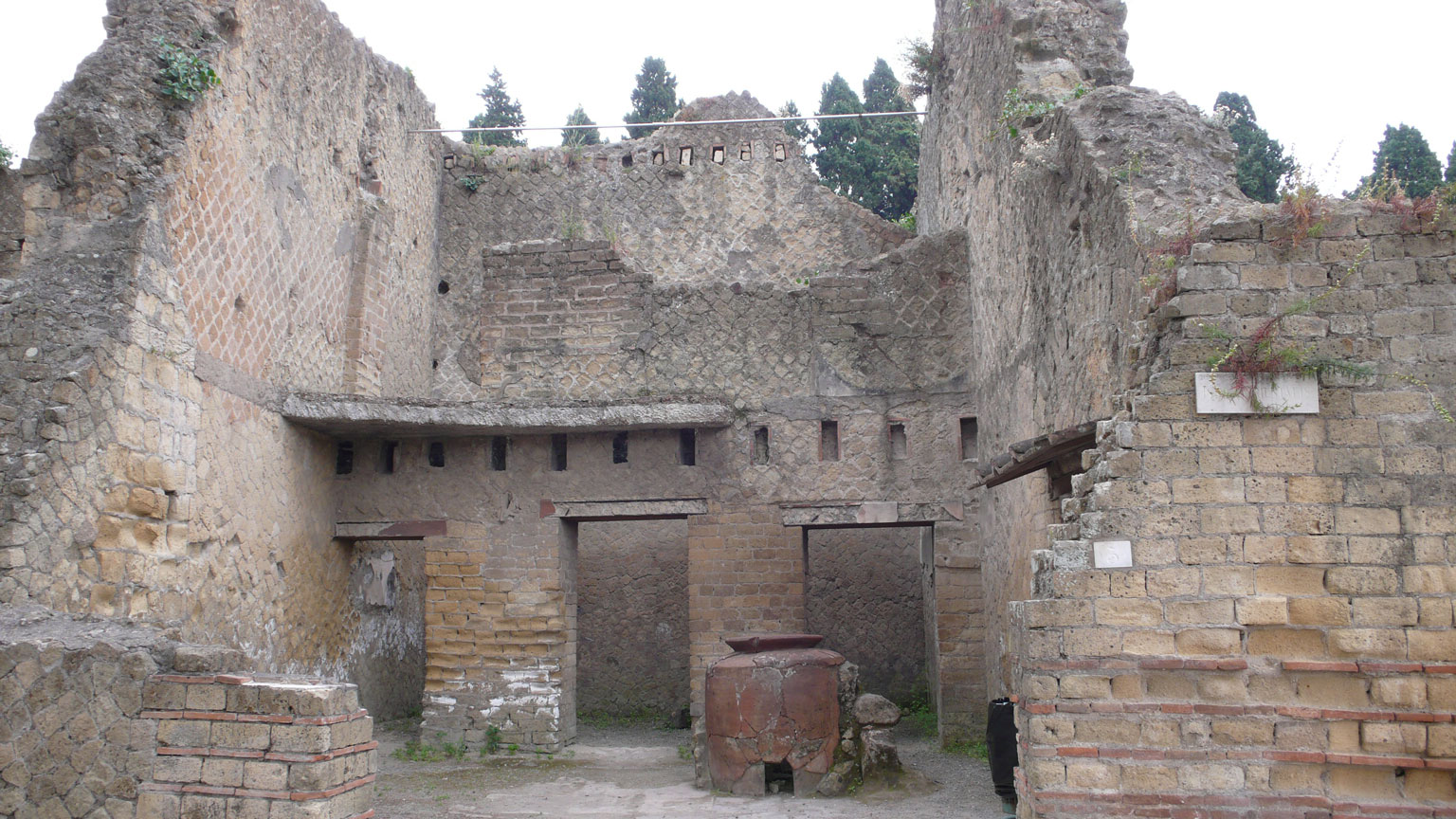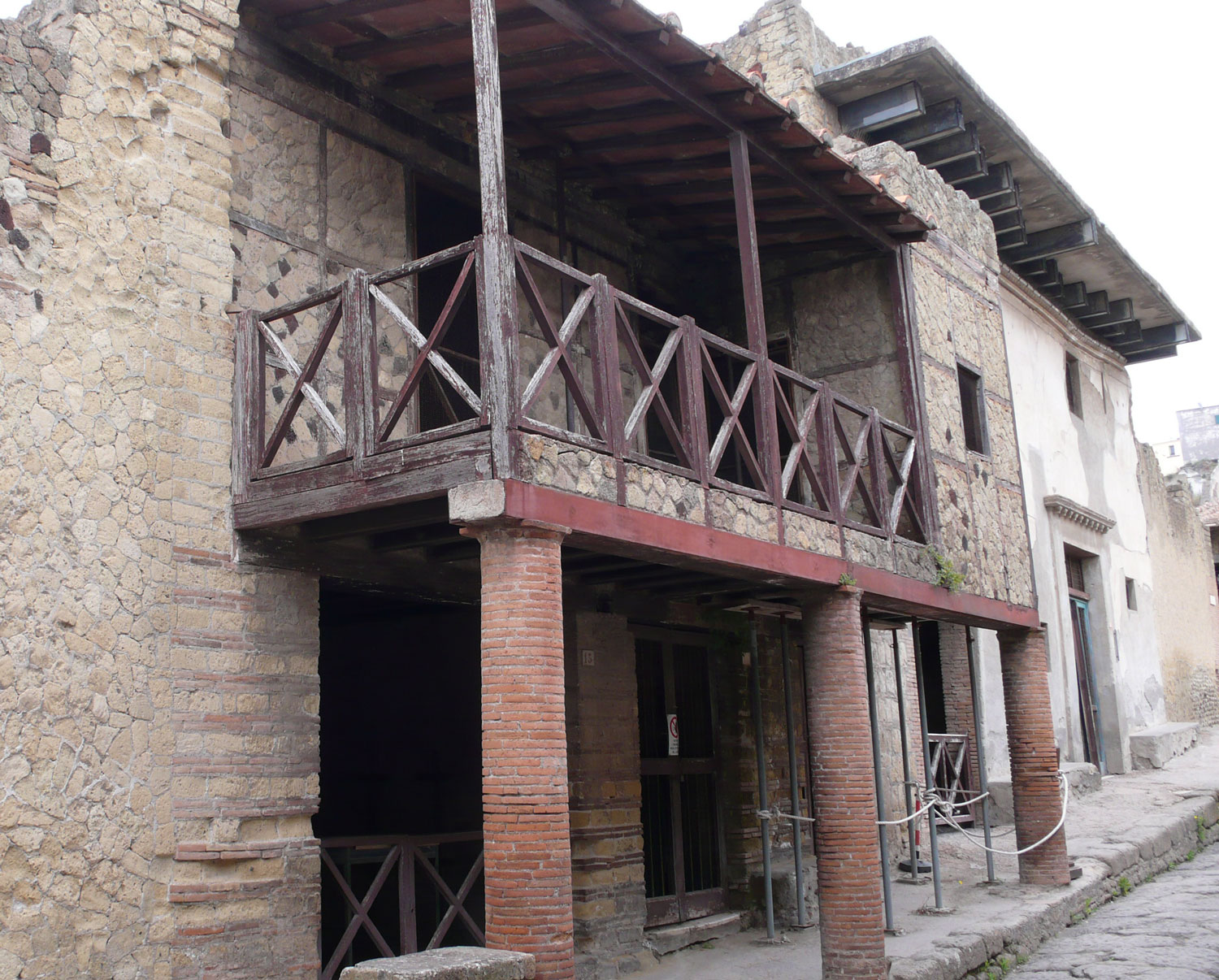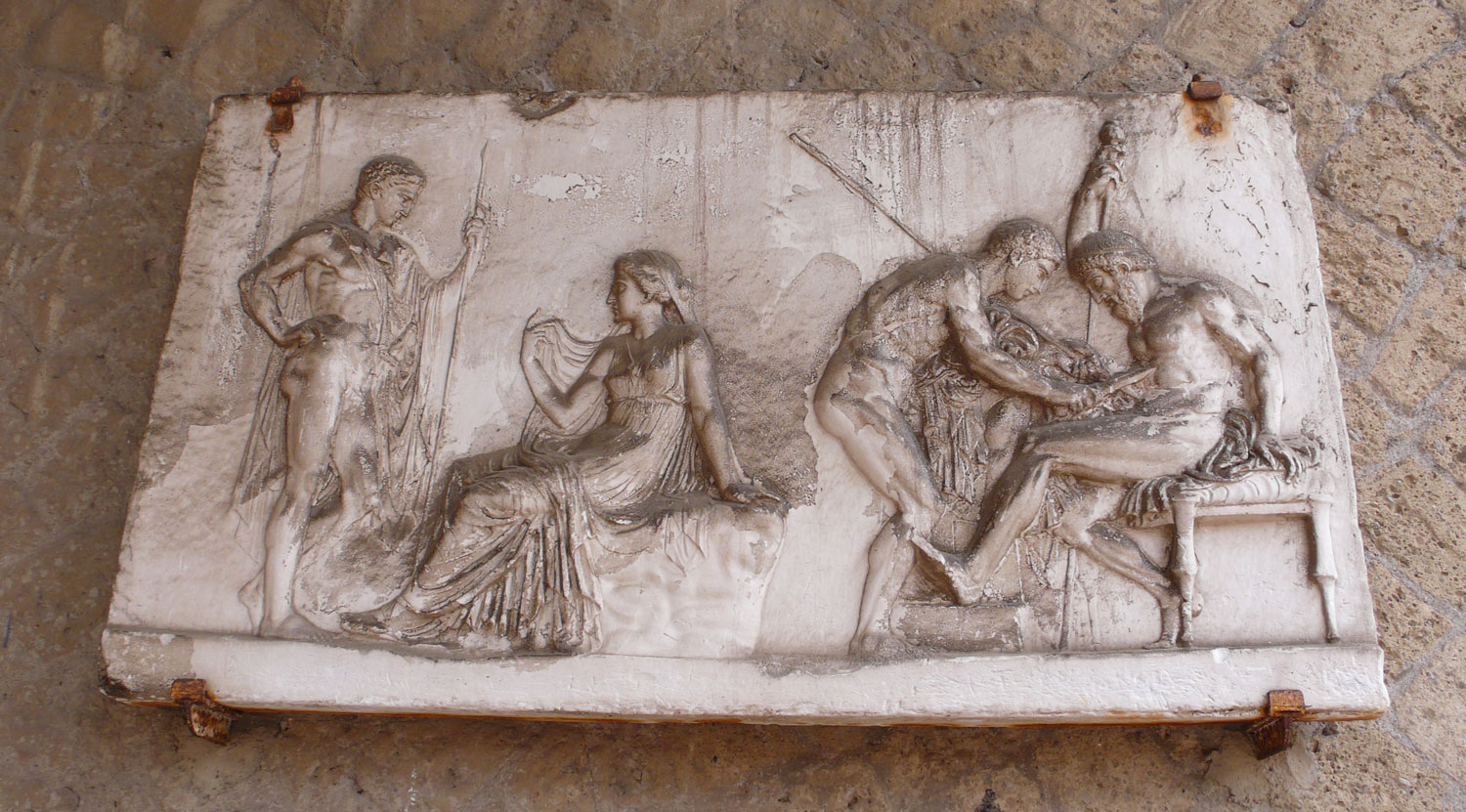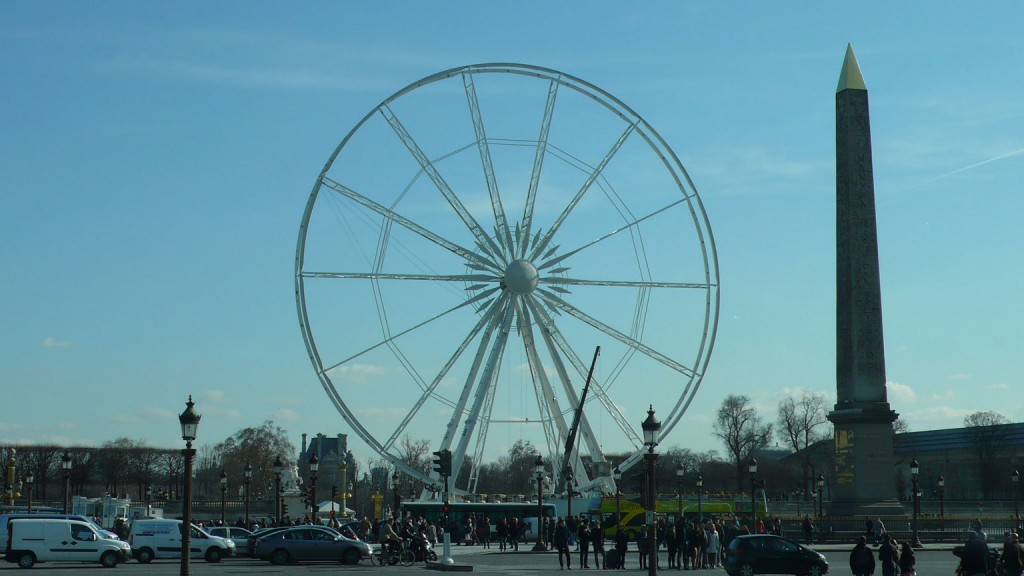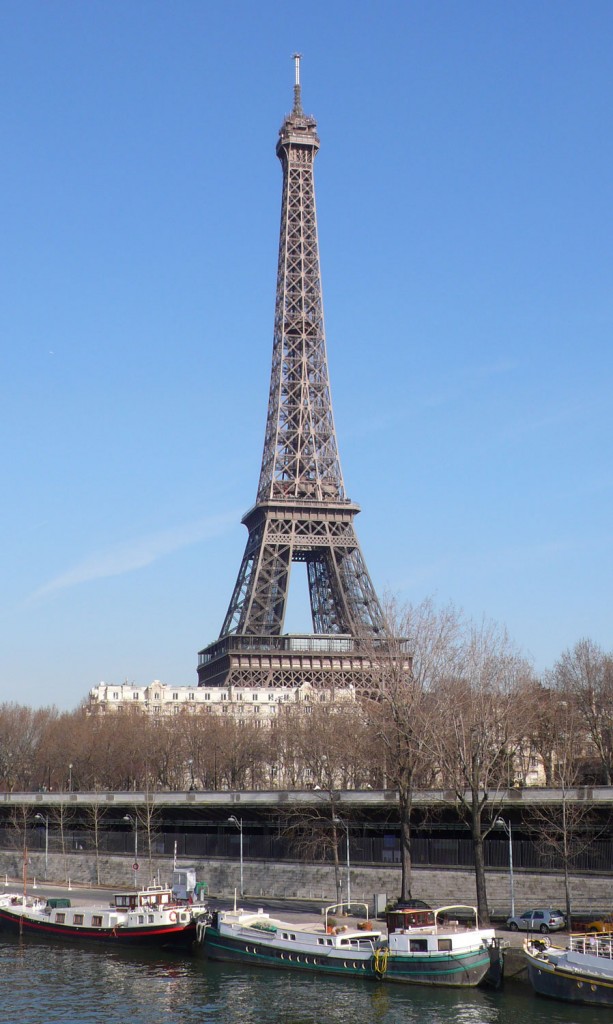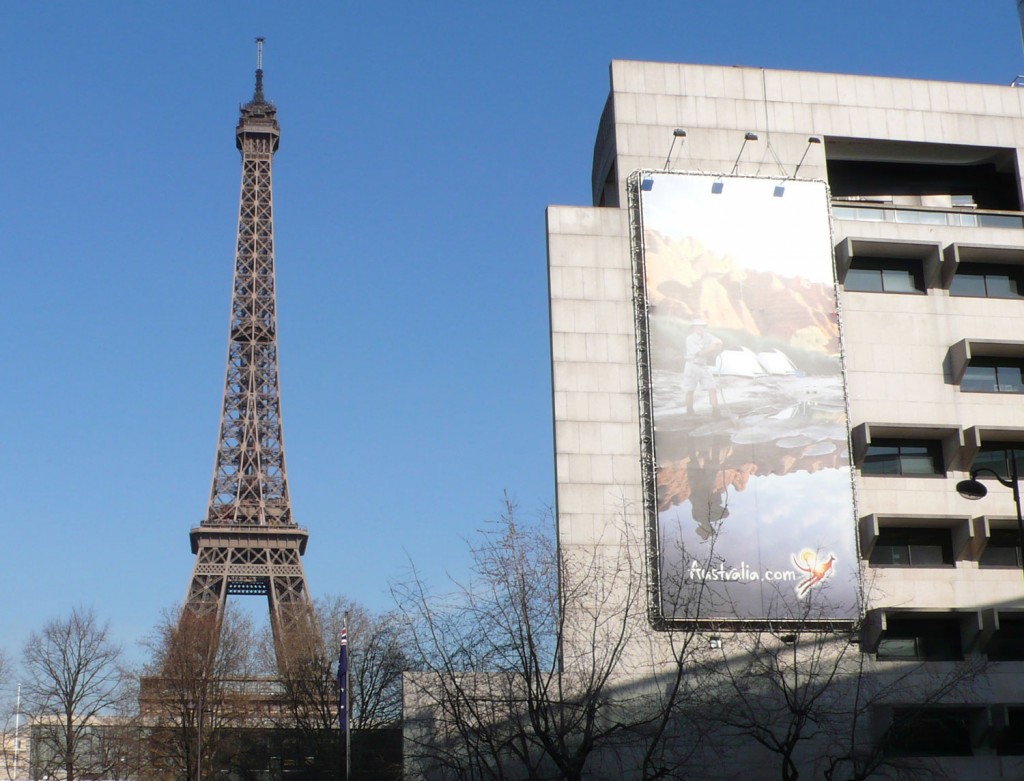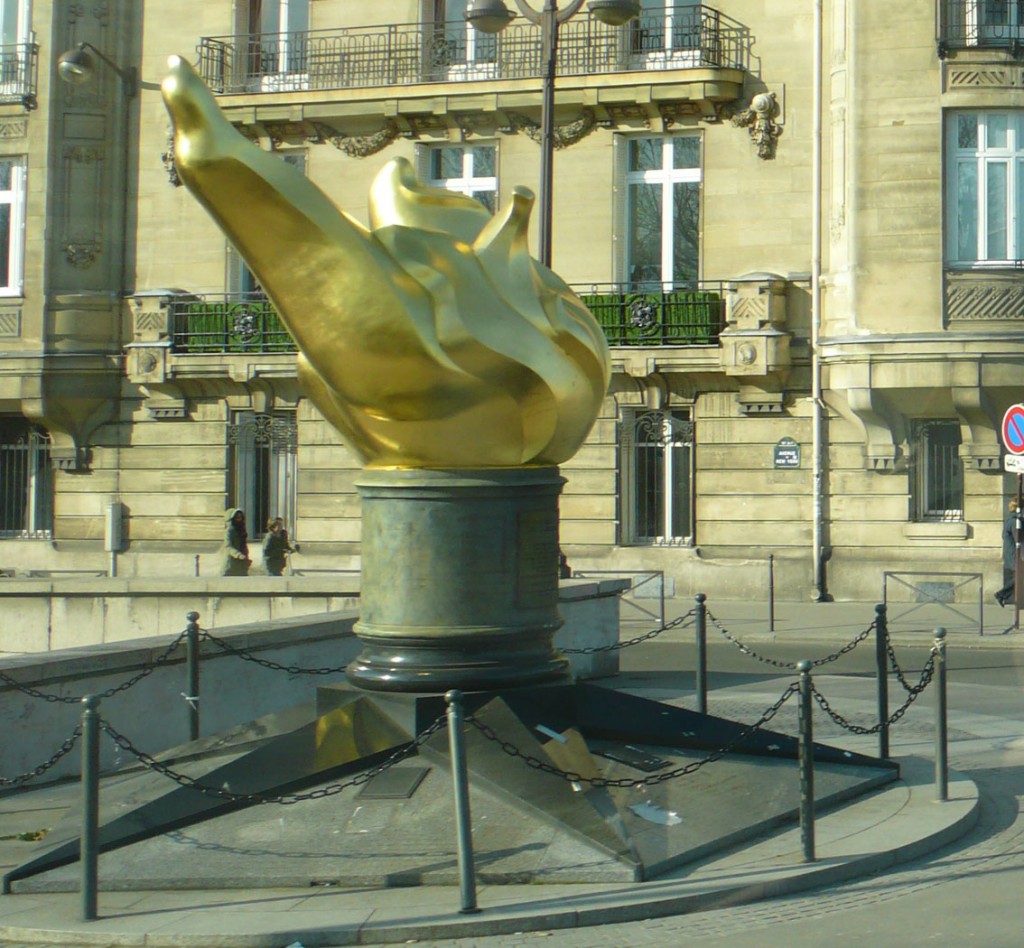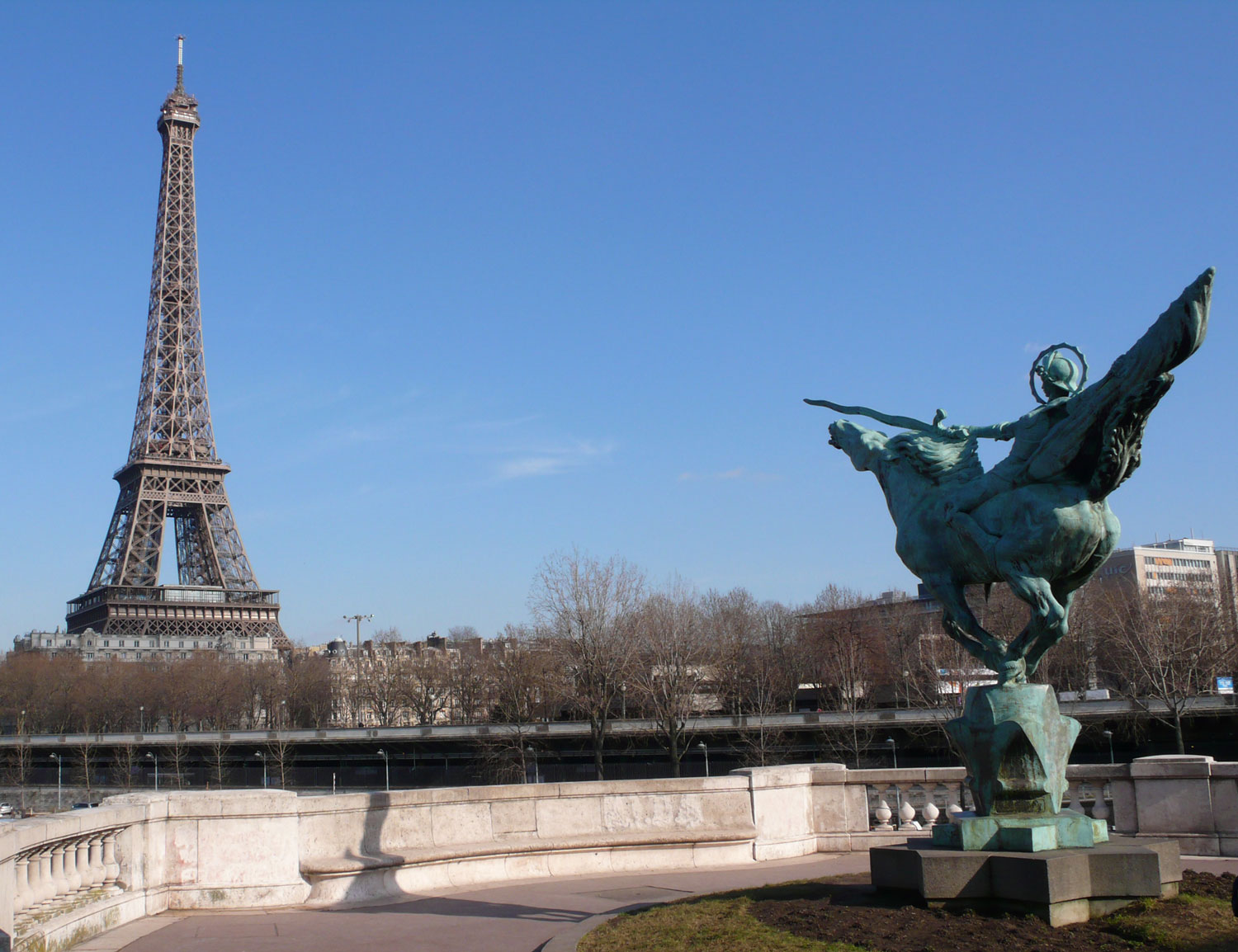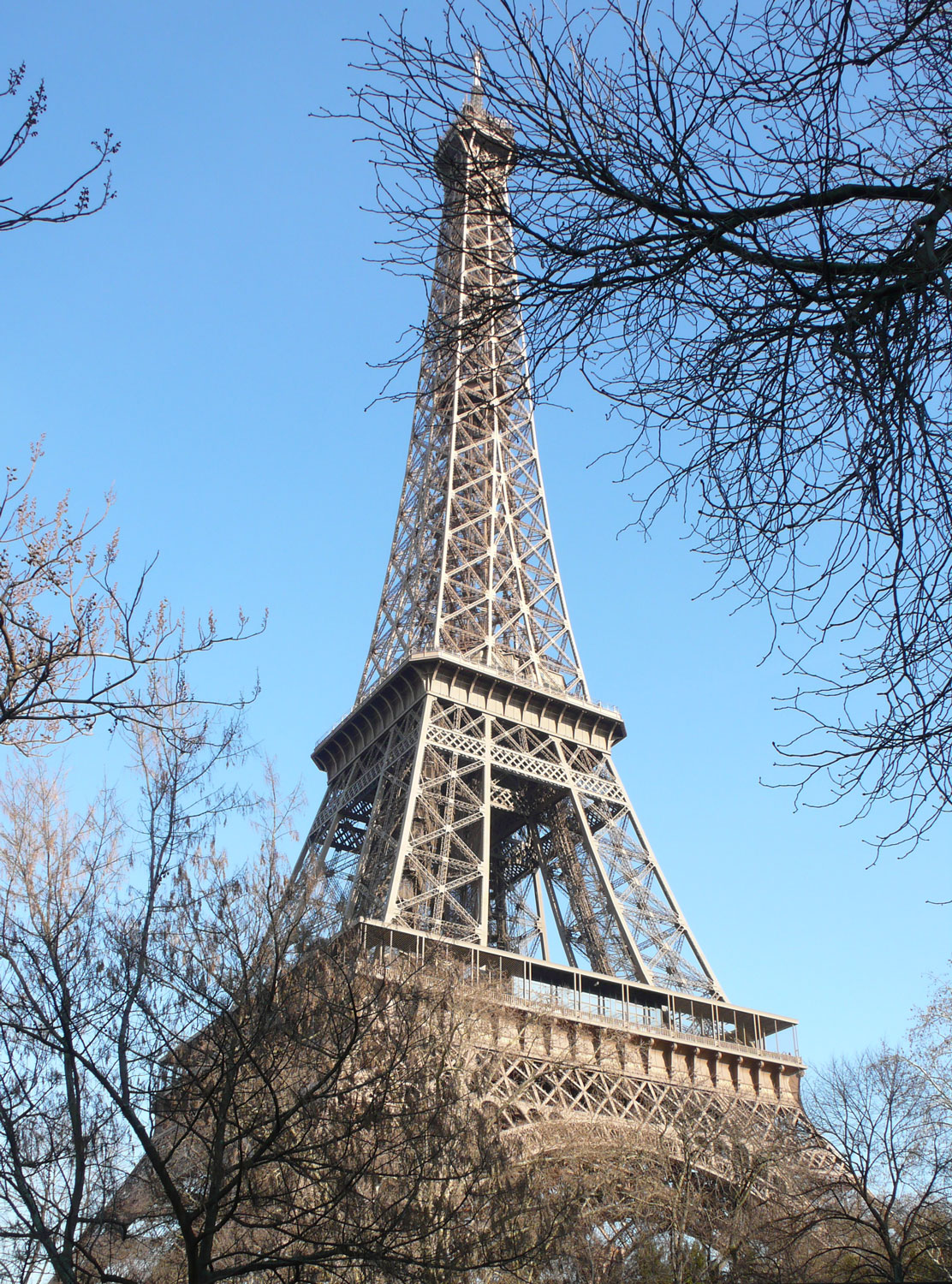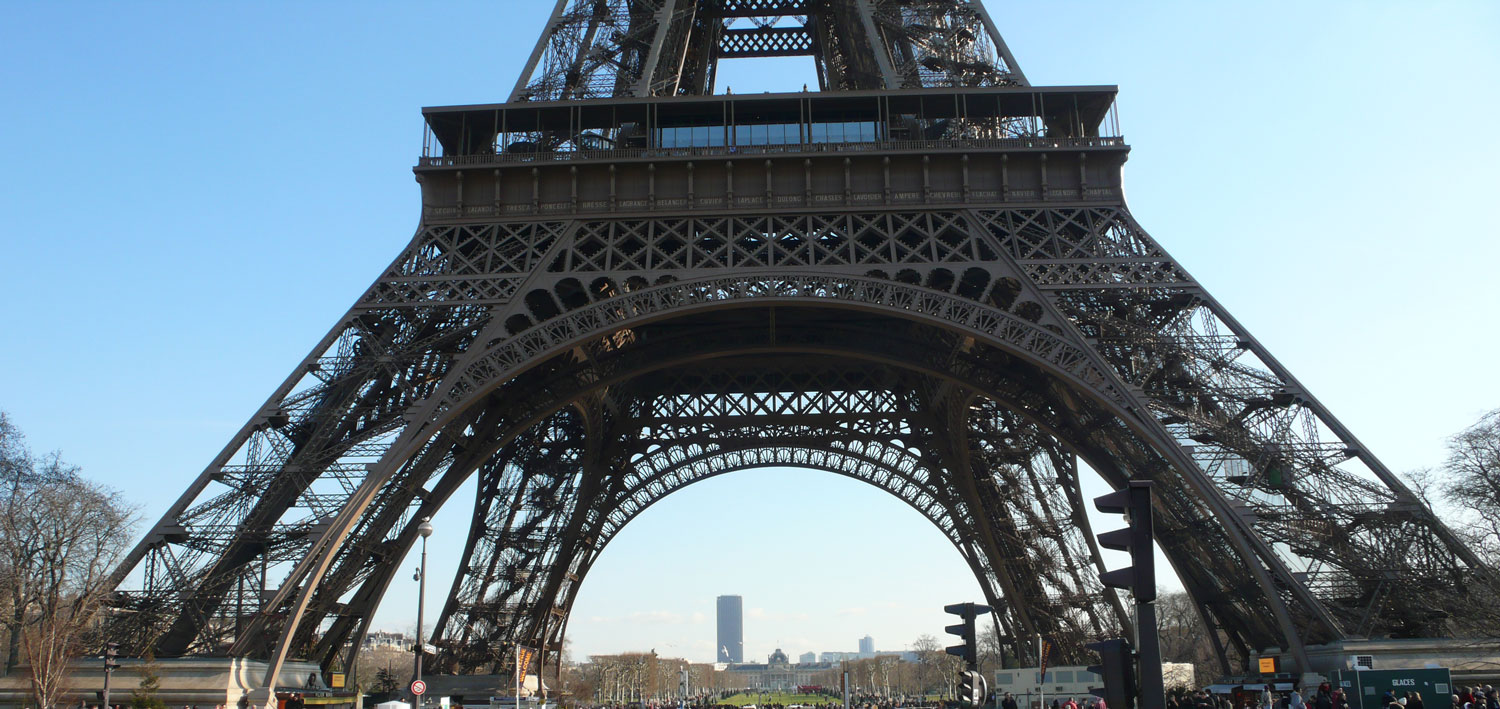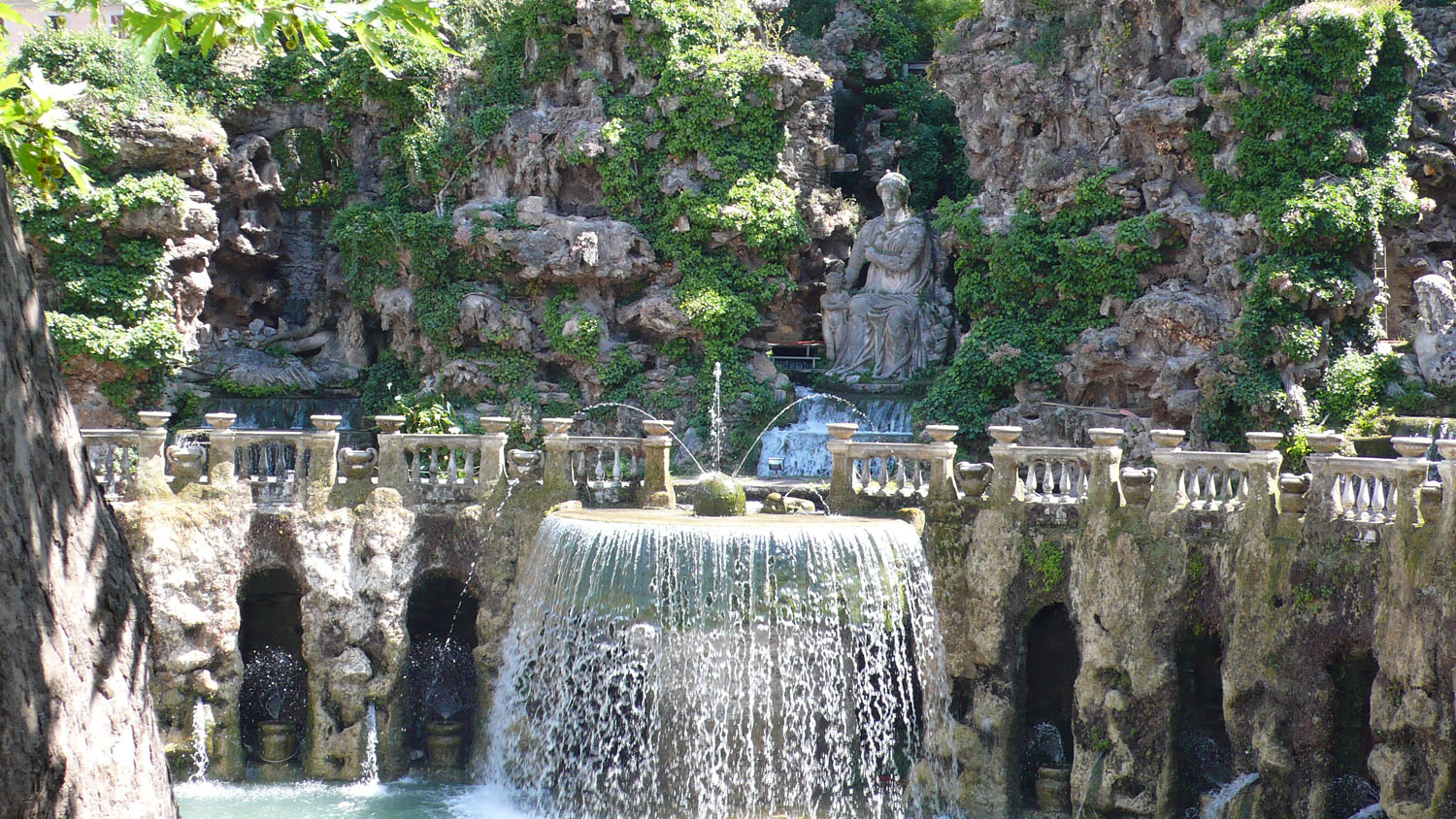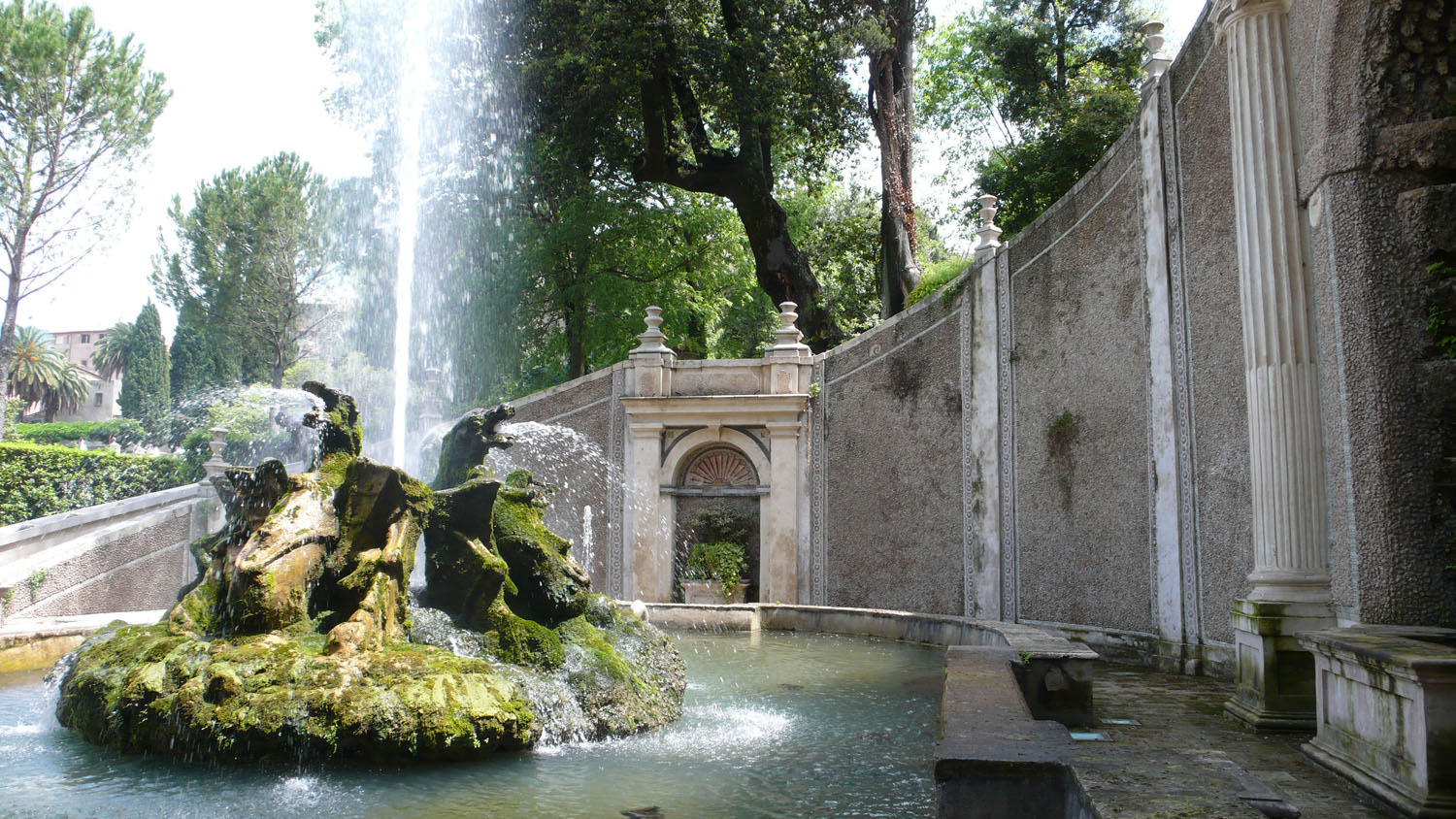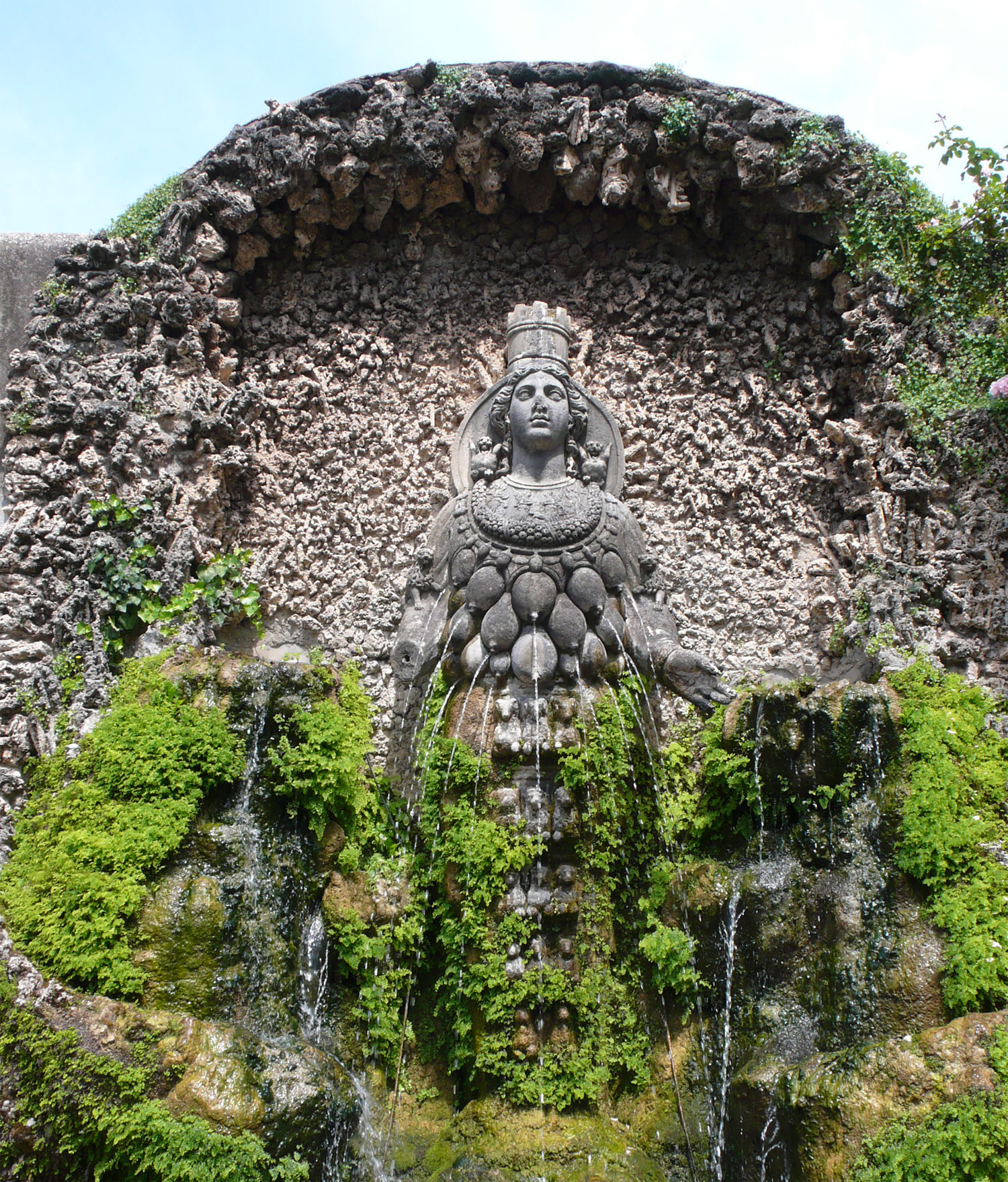Like many people, I had been fascinated by Pompei since I was a child, but I had never heard of Herculaneum (Ercolano in Italian) which was also destroyed when Vesuvius erupted in AD 79. Pompeii was impressive, but it was Herculaneum I was really taken with. It was a smaller town but had a wealthier population than Pompeii and was not discovered until 1709, meaning that it is far better preserved and less pillaged. Like Pompeii, it’s very easy to get to from Naples on the Circumvesuviana train. It only takes 25 minutes and in another 15 minutes, you’re in Pompeii. I suggest Pompeii in the morning and Herculaneum in the afternoon if you only have a day.
All posts by Rosemary Kneipp
Who’s Kevin Rudd?
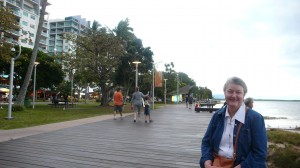 After living in France for more than 35 years, I’m not sure I really know who I am any more. I mean in terms of nationality. When we go back to Australia on holidays, I feel a bit odd because I don’t know how things “work” any more. It always amuses Relationnel that I can’t recognise the coins. Here I am, with my Australian accent, saying to the person at the cash desk, “Is this a dollar? Is this 10 cents?”. Sometimes I actually get congratulated on my excellent English! I just say “thank you”.
After living in France for more than 35 years, I’m not sure I really know who I am any more. I mean in terms of nationality. When we go back to Australia on holidays, I feel a bit odd because I don’t know how things “work” any more. It always amuses Relationnel that I can’t recognise the coins. Here I am, with my Australian accent, saying to the person at the cash desk, “Is this a dollar? Is this 10 cents?”. Sometimes I actually get congratulated on my excellent English! I just say “thank you”.
But the funniest experience was when we were up in North Queensland in August 2009. We were staying in Cairns in a big hotel opposite the esplanade. I’d noticed all the barbecues along the waterfront but had no idea how to use them. So I asked a table of Australians about our age if they could show me how they worked. A lady very nicely came and explained and off we went to buy some steak.
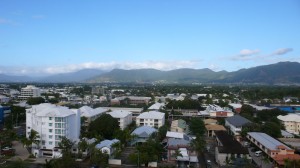 We were eating away, having shown some young Koreans how to use the barbecue as well, when the same lady came over to see me. With great excitement, she showed me her digital camera, “Look! look who it is!”. But I can never see anything on those tiny screens anyway and it was already nighttime. “I’m sorry, but I can’t see it very well”. “It’s Kevin Rudd!”, she said, bubbling over with the thrill of it all. And you know the punch line already, because you’ve seen the title of the post. What was my response ? “Who’s Kevin Rudd?”
We were eating away, having shown some young Koreans how to use the barbecue as well, when the same lady came over to see me. With great excitement, she showed me her digital camera, “Look! look who it is!”. But I can never see anything on those tiny screens anyway and it was already nighttime. “I’m sorry, but I can’t see it very well”. “It’s Kevin Rudd!”, she said, bubbling over with the thrill of it all. And you know the punch line already, because you’ve seen the title of the post. What was my response ? “Who’s Kevin Rudd?”
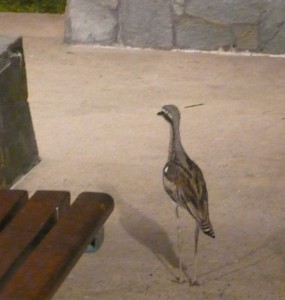 She looked at me in utter bewilderment, “Aren’t you Australian?” “Yes”, I replied, smiling sweetly. “Oh”, she said. “Well, he’s the Prime Minister”. Then, regaining her lost excitement, “He just stopped by and had a beer with us!” “Ah”, I replied, “That’s very nice”. She went off rather dispiritedly. I’d obviously put a damper on the occasion.
She looked at me in utter bewilderment, “Aren’t you Australian?” “Yes”, I replied, smiling sweetly. “Oh”, she said. “Well, he’s the Prime Minister”. Then, regaining her lost excitement, “He just stopped by and had a beer with us!” “Ah”, I replied, “That’s very nice”. She went off rather dispiritedly. I’d obviously put a damper on the occasion.
As we were leaving, after being visited by a friendly curlew, a group of young Germans stopped us and said they’d been told they couldn’t have alcohol on the beach and wanted to know whether it was really true. “Well”, I replied, “it seems that the Prime Minister just came by and he had a beer. So I don’t see why you can’t!”.
I’ve been keeping up more with Australian politics since then. I know who Julia Gillard is. She’s a woman after all. And she and Rudd have both hit the French newspapers! Not that either of them can rival with Marine Le Pen and Sarkozy!
Leonardo: Paris Below the Surface
Have you ever wondered what lies under the beautiful streets of Paris? Leonardo tells all in my latest contribution to My French Life, the online magazine & global community of French & francophiles.
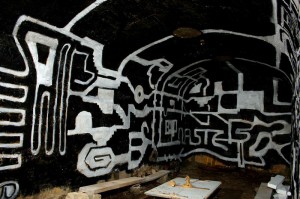 “Most people have heard of the catacombs, which are actually an ossuary. But few have heard about the other underground activities that have been taking place beneath the city of Paris for centuries. My son, Leonardo, knows all about them, so I decided to interview him. I haven’t given specific details because the regulars don’t want what they call ‘tourists’ down there as they are not always respectful of the unwritten rules of the underground subculture.” Read more
“Most people have heard of the catacombs, which are actually an ossuary. But few have heard about the other underground activities that have been taking place beneath the city of Paris for centuries. My son, Leonardo, knows all about them, so I decided to interview him. I haven’t given specific details because the regulars don’t want what they call ‘tourists’ down there as they are not always respectful of the unwritten rules of the underground subculture.” Read more
Powerwalking down to Pont Neuf – Part 3
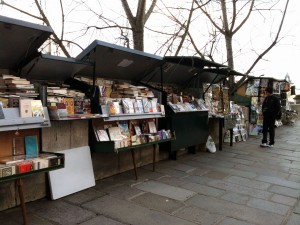 Last time, in Part 2, I told you about Saint Germain l’Auxerrois but the time before, in Part 1, I explained about Pont Neuf actually being the oldest bridge in Paris. After leaving Saint Germain, you turn left along the Seine to the bridge. Halfway across, there is an equestrian statue in honour of Henry IV and wonderful views on either side. Turn right after the bridge and you’ll go past the bouquinistes selling their second-hand books and anything else they think tourists might be interested in.
Last time, in Part 2, I told you about Saint Germain l’Auxerrois but the time before, in Part 1, I explained about Pont Neuf actually being the oldest bridge in Paris. After leaving Saint Germain, you turn left along the Seine to the bridge. Halfway across, there is an equestrian statue in honour of Henry IV and wonderful views on either side. Turn right after the bridge and you’ll go past the bouquinistes selling their second-hand books and anything else they think tourists might be interested in.
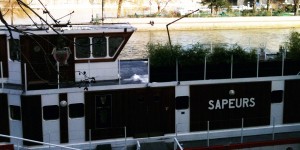 A little further on, you’ll see what is probably the most unusual fire station in Paris – it’s a river boat! Paris actually has a surprising number of fire stations. There are two in our neighbourhood alone. As soon as the weather permits, they take their fire trucks out in the street to clean them. I personally think they want to show off their uniforms as well! Last Sunday, when we were going to the market, there was a fireman standing by watching a firewoman (?) hosing down a truck – and giving instructions on how to do it, of course!
A little further on, you’ll see what is probably the most unusual fire station in Paris – it’s a river boat! Paris actually has a surprising number of fire stations. There are two in our neighbourhood alone. As soon as the weather permits, they take their fire trucks out in the street to clean them. I personally think they want to show off their uniforms as well! Last Sunday, when we were going to the market, there was a fireman standing by watching a firewoman (?) hosing down a truck – and giving instructions on how to do it, of course!
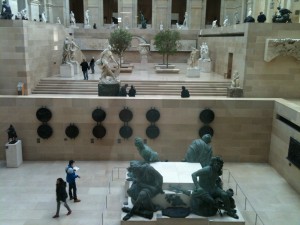 And now I have a bit of etymology for you. You might notice that the boat says “sapeurs“. Firemen in French are called “sapeurs-pompiers“. This is because in the Middle Ages, the first firemen often had to knock down (saper) the houses around the one that was burning to stop the fire from going any further. The “pompier” bit comes from pumping water.
And now I have a bit of etymology for you. You might notice that the boat says “sapeurs“. Firemen in French are called “sapeurs-pompiers“. This is because in the Middle Ages, the first firemen often had to knock down (saper) the houses around the one that was burning to stop the fire from going any further. The “pompier” bit comes from pumping water.
If you keep going, you’ll arrive at the Passerelle des Arts and can admire all the padlocks as you go past. Cross rue de Rivoli and walk through to the Place Carrée du Louvre, then left to the pyramids and right through the arcade with its wonderful plate glass windows and view of some of the museum’s antique sculptures.
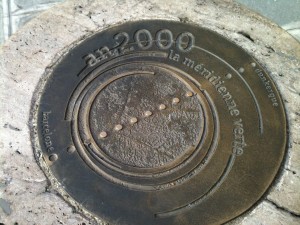 Just in front of the Conseil Constitutionnel, you’ll see a rather nondescript column with a plaque on top saying “an 2000 la méridienne verte“. This was a project promoted by Paul Chemetov to celebrate the year 2000. Trees were planted along the Paris meridian which crosses France from North to South (from Dunkirk to Prats-de-Mollo-la-Preste). A big picnic was held that year on Bastille Day right along the meridian. Wish I’d known about it!
Just in front of the Conseil Constitutionnel, you’ll see a rather nondescript column with a plaque on top saying “an 2000 la méridienne verte“. This was a project promoted by Paul Chemetov to celebrate the year 2000. Trees were planted along the Paris meridian which crosses France from North to South (from Dunkirk to Prats-de-Mollo-la-Preste). A big picnic was held that year on Bastille Day right along the meridian. Wish I’d known about it!
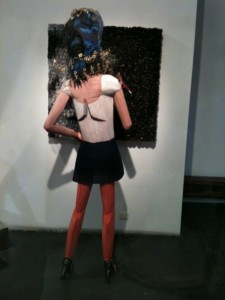 Turn right onto Place Colette, home of the Comedie Française theatre where Molière died, with its scaffolding, then through the arcade to the Buren columns. In front you’ll see a wooden building which is temporarily housing the theatre. Walk around it to the right and take a look at the exhibitions after the portico. They do have the weirdest things! But they’re often very clever, like the ones in the Pompidou Centre. A little look to see what Miss Bibi‘s up to and then I’m ready to climb the stairs to the 4th floor!
Turn right onto Place Colette, home of the Comedie Française theatre where Molière died, with its scaffolding, then through the arcade to the Buren columns. In front you’ll see a wooden building which is temporarily housing the theatre. Walk around it to the right and take a look at the exhibitions after the portico. They do have the weirdest things! But they’re often very clever, like the ones in the Pompidou Centre. A little look to see what Miss Bibi‘s up to and then I’m ready to climb the stairs to the 4th floor!
If you enjoyed reading this, don’t forget to subscribe to new posts – that way you’ll get them directly on your smart phone or in your mail box! And I love to hear your comments!
Sewing Machines I Have Known
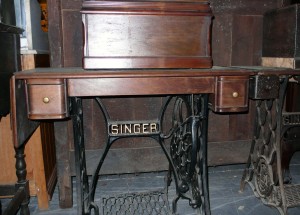 Last Sunday when we were on another dépôt-vente excursion, I came across two Singer treadle sewing machines, one of which seemed in very good condition and a bargain at 40 euros. A nostalgia trip of course. My first sewing machine was one of those little kid’s ones that only did chain stitch. For the uninitiated, it means that you just had to pull on the thread and the whole lot would come undone.
Last Sunday when we were on another dépôt-vente excursion, I came across two Singer treadle sewing machines, one of which seemed in very good condition and a bargain at 40 euros. A nostalgia trip of course. My first sewing machine was one of those little kid’s ones that only did chain stitch. For the uninitiated, it means that you just had to pull on the thread and the whole lot would come undone.
I was a devoted sewer as a child. I had a Barbie doll that I made clothes for, including miniature bras and pants and skirts with zippers. So I was certainly not going to be satisfied with a machine that only did chain stitch. Mum didn’t think at 9 or 10 that I was old enough to use her electric Singer machine but I was very insistent so she bought me a hand-operated Singer.
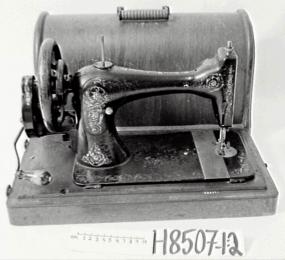
I used to set it up on a low table on the veranda and sew away to my heart’s content. But I soon saw the limits of a hand-operated machine, particularly as Mum’s did zigzag and made buttonholes. She told me that the day I could sew a straight line in a piece of material without any markings, I could use her machine. Well, I mastered that in next to no time and migrated to the real thing. At school, we used treadle machines and I used to help all the others when they got stuck. We made boring things such as aprons.
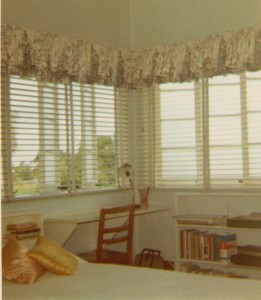 By 13, I was making my own clothes. By 16, I was making everything I wore. I could take the machine to pieces and put it back together as well! And do you know what happened to the hand-operated machine? I decided when I was a teenager to redecorate my bedroom. I made little “flutter” curtains with sketches of Montmartre on them (already getting ready to live the French dream) and desperately wanted a white chenille bedspread. But Mum, very practical, was against it. I was not known for my tidiness. So I sold the sewing machine to buy the white bedspread myself!
By 13, I was making my own clothes. By 16, I was making everything I wore. I could take the machine to pieces and put it back together as well! And do you know what happened to the hand-operated machine? I decided when I was a teenager to redecorate my bedroom. I made little “flutter” curtains with sketches of Montmartre on them (already getting ready to live the French dream) and desperately wanted a white chenille bedspread. But Mum, very practical, was against it. I was not known for my tidiness. So I sold the sewing machine to buy the white bedspread myself!
When I came to France, the thing I most missed was Mum’s sewing machine. I’d practically made a whole new wardrobe before I left, because living in Townsville meant I only had summer clothes. So I made woollen skirts and tailored jackets that stood me in good stead for quite a while. I must have borrowed a machine from time to time though because I can remember some of the clothes I made in those early years in France.
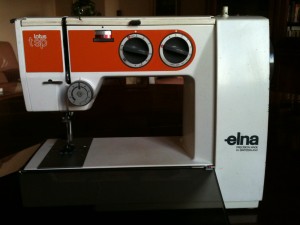 Mum’s wedding present was a sewing machine. We went together to choose it at the BHV in Paris. By then, I wanted something more sophisticated of course that would sew things like jersey. I also needed something compact so I chose a little Elna. Mum bought the machine and then announced she was going off for the rest of the day by train to Liseux in Normandy, to see the church of Saint Therese. I didn’t know what to do. Mum didn’t speak French and Dad would never forgive me if I let her go by herself. What if something happened? I was getting married in two days’ time! But how can you stop your own (very determined) mother from doing something?
Mum’s wedding present was a sewing machine. We went together to choose it at the BHV in Paris. By then, I wanted something more sophisticated of course that would sew things like jersey. I also needed something compact so I chose a little Elna. Mum bought the machine and then announced she was going off for the rest of the day by train to Liseux in Normandy, to see the church of Saint Therese. I didn’t know what to do. Mum didn’t speak French and Dad would never forgive me if I let her go by herself. What if something happened? I was getting married in two days’ time! But how can you stop your own (very determined) mother from doing something?
So I took her to the station and helped her buy the ticket and went home to face the music. After calculating the time she would need to go there and back, Dad spent a couple of hours down at the bus stop waiting for her! She came home safe and sound, perfectly delighted with herself and her ability to get around France on her own. Mothers!!
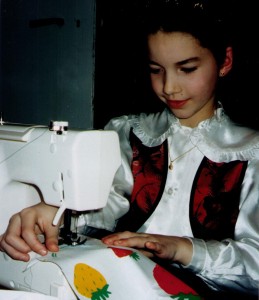 My trusty Elna is still going strong although I rarely do much sewing today. I made most of Black Cat’s clothes when she was little and when she was ten, I bought her an electric machine, also a Singer, a special child’s machine with two buttons – a hare and a tortoise. She didn’t use it very much to my disappointment, but I didn’t say anything. Then suddenly, when she was in her late teens, she became a keen sewer, much more adventurous than me, and she occasionally stuns everyone with a new outfit. A friend of mine has lent her a Singer, probably about the same one as Mum had!
My trusty Elna is still going strong although I rarely do much sewing today. I made most of Black Cat’s clothes when she was little and when she was ten, I bought her an electric machine, also a Singer, a special child’s machine with two buttons – a hare and a tortoise. She didn’t use it very much to my disappointment, but I didn’t say anything. Then suddenly, when she was in her late teens, she became a keen sewer, much more adventurous than me, and she occasionally stuns everyone with a new outfit. A friend of mine has lent her a Singer, probably about the same one as Mum had!
If you enjoyed reading this, don’t forget to subscribe to new posts – that way you’ll get them directly on your smart phone or in your mail box! And I love to hear your comments!
Bus 72 to the Eiffel Tower
I had to go to the Australian Embassy today and the weather was so extraordinary – 8°C with a bright blue sky – that I took bus 72 in rue de Rivoli, just opposite the Louvre. I tried to use my iPhone app to see when the bus was coming but someone had tagged the little black & white thing so I couldn’t scan it. The bus didn’t take long anyway.
We went down rue de Rivoli, past the Tuileries Gardens on the left and some of Paris’ best known luxury hotels on the right – Le Meurice, the Saint James and Albany, the Brighton, the Régina – not to mention Angelina’s. The bus then stopped right on Place de la Concorde with a spectacular view of Cleopatra’s Needle, the Louvre, the Ferris Wheel, the National Assembly and the Arc of Triumph. It then swung left and right to follow the river down to the Eiffel Tower.
We went past the Petit Palais, the Grand Palais, the Palais de la Découverte and Trocadero. I got off at Pont Bir Hakeim, an elegant metal bridge built in 1905, to walk across to the Embassy. The bridge has the best views of the Eiffel Tower and is the most popular venue for seeing the fireworks on Bastille Day and heralding in the New Year. I had a real field day! The light was exactly right and I couldn’t stop taking photos.
After the Embassy, I walked down to the Eiffel Tower. I never cease to be amazed at just how big it is up close. We can see it from our living room window but it’s obviously much smaller at a distance. From there I crossed back over the river via Pont d’Iéna, a stone bridge built by Bonaparte a century earlier. More photos of the Eiffel Tower with Trocadero behind me. I took bus 72 again a few metres to the right after the bridge.
Further down, on your left, you can see the gold Flamme de la Liberté which is a memorial to Princess Diana who died in a car accident in the Pont de l’Alma tunnel in 1997. We continued down past Place de la Concorde with a wonderful view of the twin hôtels designed by Ange-Jacques Gabriel (what a name!) at the same time as the Place, but the bus was rattling along at such a pace that I wasn’t able to take photos. I decided to get off opposite the Orsay Museum and walk the rest of the way, crossing over in front of the majestic end pavilion of the Louvre.
As I was walking towards the Arc du Carousel, I heard someone call my name. Amazing what a small world it is!
Slow Walking on Rue du Louvre
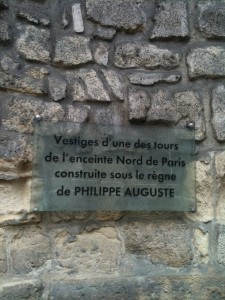 Now if you happen to walk down Rue du Louvre, with your back to the Seine, you should stay on the left side until you come to the remains of a stone wall that is actually part of the fortress built by Philippe Auguste at the end of the 12th century to protect Paris while he was off at the Crusades. It was later to become the Louvre.
Now if you happen to walk down Rue du Louvre, with your back to the Seine, you should stay on the left side until you come to the remains of a stone wall that is actually part of the fortress built by Philippe Auguste at the end of the 12th century to protect Paris while he was off at the Crusades. It was later to become the Louvre.
Cross over to the other side and you’ll come to a large round building. Few people realise that it’s open to the public and that you can just wander in. It used to be the Bourse du Commerce which, despite its name, isn’t the stockmarket which is about ten minutes away, but the commodities market. It was originally built by Louis-Philippe in 1763 to store and sell wheat. Its location was chosen due to the proximity of the Seine and it was financed by constructing rental buildings around it.
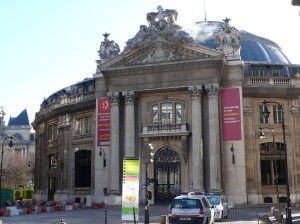 Today it’s the Chamber of Commerce and Industry. It’s built on a circular plan, 122 metres in circumference. There were two concentric galleries above 25 covered arcades. The galleries housed the police, the weights and measures office and the statistics bureau. Enormous wheat lofts on the first floor were accessed via two beautiful spiral staircases, one of which had a double revolution so that the administrative staff and merchants didn’t have to rub shoulders with the porters! The courtyard was orginally open but later covered with a wooden dome to protect the wheat.
Today it’s the Chamber of Commerce and Industry. It’s built on a circular plan, 122 metres in circumference. There were two concentric galleries above 25 covered arcades. The galleries housed the police, the weights and measures office and the statistics bureau. Enormous wheat lofts on the first floor were accessed via two beautiful spiral staircases, one of which had a double revolution so that the administrative staff and merchants didn’t have to rub shoulders with the porters! The courtyard was orginally open but later covered with a wooden dome to protect the wheat.
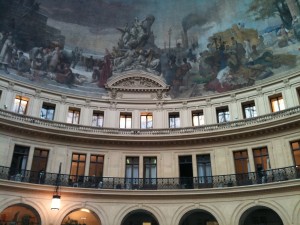 After a second fire in 1854, the building was closed for 30 years before being renovated and converted into a commodities market in 1885. Wheat, rye, oats, flour, oil, sugar, spirits, rubber, cocoa, coffee, potatoes, and rape were sold by auction until 1998 when it was disbanded due to computerisation of the futures market. If you stand right in the middle and speak, your voice will be amplified. The inside is decorated with murals depicting the four cardinal points. You’re not supposed to take photos, I discovered after I got to the third cardinal point, so you’ll just have to go and see for yourself !
After a second fire in 1854, the building was closed for 30 years before being renovated and converted into a commodities market in 1885. Wheat, rye, oats, flour, oil, sugar, spirits, rubber, cocoa, coffee, potatoes, and rape were sold by auction until 1998 when it was disbanded due to computerisation of the futures market. If you stand right in the middle and speak, your voice will be amplified. The inside is decorated with murals depicting the four cardinal points. You’re not supposed to take photos, I discovered after I got to the third cardinal point, so you’ll just have to go and see for yourself !
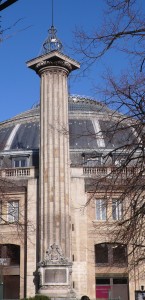 Just next to the Bourse du Commerce, you’ll see a tall column which has an interesting history. It’s the last vestige of a private hôtel built by Catherine de Médicis in 1572. The queen had the 31-metre high tower built for her astrologist, Cosimo Ruggieri. They often used to go up to the top of the tower together, where he whispered, not sweet nothings, but magic spells.
Just next to the Bourse du Commerce, you’ll see a tall column which has an interesting history. It’s the last vestige of a private hôtel built by Catherine de Médicis in 1572. The queen had the 31-metre high tower built for her astrologist, Cosimo Ruggieri. They often used to go up to the top of the tower together, where he whispered, not sweet nothings, but magic spells.
The top part of the column used to be glassed in but all that’s left today is a metal frame. After Ruggieri died in 1615, it fell into disuse and the building was demolished in 1748 to pay the debts of the last owner, Amédée de Savoie. Only the tower was saved and bought by the City of Paris in 1750. A fountain was added, which has now run dry, and a sundial. Legend has it that on stormy nights, a long black silhouette appears in the iron cage every time there’s a flash of lightening! I’ll let you go and check that out as well too.
If you enjoyed reading this, don’t forget to subscribe to new posts – that way you’ll get them directly on your smart phone or in your mail box! And I love to hear your comments!
Sunday’s Travel Photos – Tivoli Gardens, Italy
The Villa d’Este, more often call the Tivoli Gardens, is an easy visit from Rome. It’s no surprise that it’s on the UNESCO world heritage list. It has the most impressive number of fountains, nymphs and grottoes you could possibly imagine. It really is sheer magic. I nearly didn’t put the last photo in, because I think it’s actually rather grotesque, but it’s so well known that I thought I couldn’t leave it out!
My Croatian Itinerary – Part 1: Paris to Milan
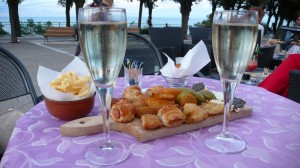
Now that we’ve given up spontaneous travelling and plan our itinerary practically down to the last detail, we spend a lot of time pouring over guide books. Or rather, Relationnel does, because I do the bookings (much more productive in English because you have a greater choice) and then once the holiday has begun, I do the talking because Relationnel’s capacity in this respect is somewhat limited. He keeps reading the guide books. And we both write up our (French) travel diary over our daily apéritif, one of the best moments of the day!
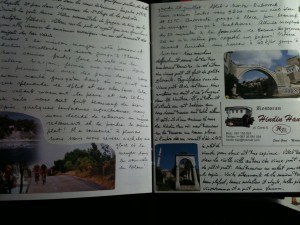
Once I had convinced him into going to Croatia and Slovenia, we bought an enormous map of Europe to determine how to get there and back by car. There was no really obvious route, so in the end, we decided to go across Italy and take the ferry at Ancona on the Adriatic Coast across to Split in Croatia then come back overland via Germany. The next step was to see how we would divide up our 28 days. We have discovered that, on the whole, it’s very tiring to change places too often so we usually alternate 2 and 3-day stays. We also try to keep the journey time to a maximum of 3 hours after a 2-night stay and 5 hours after a 3-night stay. Relationnel does most of the driving.
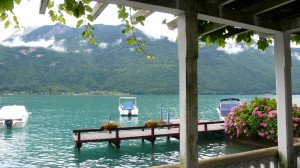
The most important booking was the ferry, because that would determine everything else. Another thing we like to do is to start the trip with 3 days somewhere in France where we can wind down and get plenty of rest and exercise before moving onto the more serious stuff. Annecy looked like a good choice, after an overnight stay in Dijon to see family. The photos of the lake in our cycling book looked very enticing. As we’d never been to Milan, we decided that would be our second stop for 2 nights before going to Ancona.
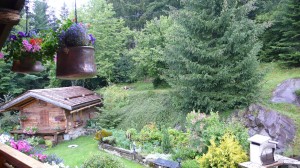
So I found a B&B about a half an hour from Annecy at a short distance from Thones. It was a cosy little wooden chalet, the owners were very friendly and helpful, we had a little kitchen to cook meals in if we wanted to and a small dining room to eat them in. There was free WIFI and the breakfast was excellent. The B&B is up on top of a hill with some lovely forest walks and views. Unfortunately, despite the fact it was mid-July the weather was cold and rainy and we were somewhat restricted in our cycling excursions as a result. But I can definitely recommend both the area and the accommodation. We had visited Annecy before, but we enjoyed going back again.
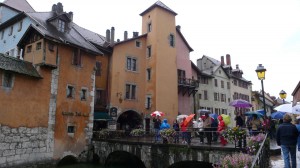
We then took the Mont Blanc tunnel to Italy. A word of warning – make sure you get there early – not like us – or you’ll find yourself in a long queue, particularly in the summer. It took us an hour of stopping and starting before we were finally able to take the extravagantly expensive 11.6 km long tunnel (38 euros one way, 49 return). It was 10°C when we left Thones and 31°C when we came out the other side of the tunnel. A rude shock!
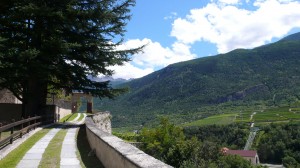
We looked for somewhere to picnic. I personally think the food on the Italian motorways is awful. They have a funny system for buying things as well. First, you have to line up at a cash desk to pay for what you want to eat and drink, then you take your tickets over to the bar and line up again. You obviously have to know exactly what you want (and know how to say it, which is worse) or someone else will push in front of you. That’s why I had cleverly packed a picnic. They also have toilets with an automatic chain which I haven’t quite mastered yet. The cappuccino‘s good!
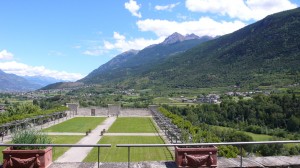
Just as we came out of Aosta, which we’ve visited several times in the past and is definitely worth a detour, I saw a beautiful castle high up on the hill on the left and decided we’d have lunch there. We followed the signs to Castello de la Sarre and parked at the bottom. We staggered out in the heat, planting our hats firmly on our heads and walked up the path, oohing and aahing at the view on the way up. We found a lovely shady spot at one end with the most spectacular panorama in front of us. We practically had the place to ourselves.
We left reluctantly, but Milan and further adventures were awaiting us!
Patricia et Rémi, Chalet Les Lupins, La Clossette Glapigny, F – 74230 THONESTel: +33 (0) 450 63 19 96, email: chaletleslupins@orange.fr, http://www.francealpes.com (65 curos / night for 2)
If you enjoyed this post, don’t forget to subscribe to new posts – that way you’ll get them directly on your smart phone or in your mail box! And I love to hear your comments!
La Saint-Valentin
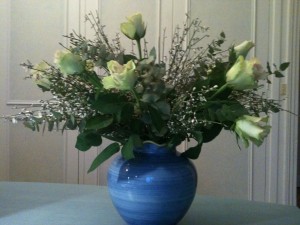 As my 9-year-old nephew in Sydney pointed out to me yesterday when I mentioned Saint Valentine’s Day to him, the “Saint” has disappeared from Valentine’s Day in English. Francophiles may wonder why it’s “la” Saint-Valentin and not “le”. Well, like all feast days, it’s short for “la fête du Saint-Valentin”. Hence the feminine for what looks like a masculine.
As my 9-year-old nephew in Sydney pointed out to me yesterday when I mentioned Saint Valentine’s Day to him, the “Saint” has disappeared from Valentine’s Day in English. Francophiles may wonder why it’s “la” Saint-Valentin and not “le”. Well, like all feast days, it’s short for “la fête du Saint-Valentin”. Hence the feminine for what looks like a masculine.
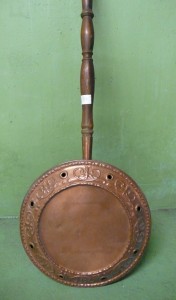 Back to the day itself. Relationnel, who is a real romantic, arrived with a bunch of roses at lunchtime. He had taken the afternoon off so we decided to go to a couple of depôt-vente and find some things to furnish and decorate Closerie Falaiseau, our new house in Blois. The temperatures have risen since our previous excursion last Saturday so my hands and feet weren’t completely frozen this time. There is a website called www.troc.com that now has 190 second-hand shops in France so we chose one about three-quarters of an hour from the centre of Paris in the western suburb of Orgeval.
Back to the day itself. Relationnel, who is a real romantic, arrived with a bunch of roses at lunchtime. He had taken the afternoon off so we decided to go to a couple of depôt-vente and find some things to furnish and decorate Closerie Falaiseau, our new house in Blois. The temperatures have risen since our previous excursion last Saturday so my hands and feet weren’t completely frozen this time. There is a website called www.troc.com that now has 190 second-hand shops in France so we chose one about three-quarters of an hour from the centre of Paris in the western suburb of Orgeval.
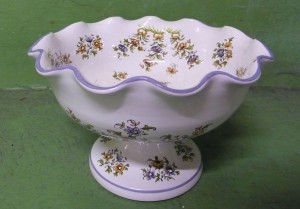 We found quite a few goodies, including a coffee grinder, a long-handled bed-warming pan, a set of pewter jugs, a coffee pot, some scales and a Moustier fruit bowl in troc.com and a new expresso/cappuccino machine and a steam iron in another place called Cash Converter, also a chain, which has a lot of musical instruments, hi-fi equipment, small appliances and other household goods. We learnt that you can see the items for sale at troc.com on-line and even reserve them. We’re going to see if we can get some dining-room chairs that way.
We found quite a few goodies, including a coffee grinder, a long-handled bed-warming pan, a set of pewter jugs, a coffee pot, some scales and a Moustier fruit bowl in troc.com and a new expresso/cappuccino machine and a steam iron in another place called Cash Converter, also a chain, which has a lot of musical instruments, hi-fi equipment, small appliances and other household goods. We learnt that you can see the items for sale at troc.com on-line and even reserve them. We’re going to see if we can get some dining-room chairs that way.
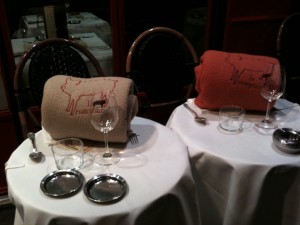 We got back to Paris just in time for dinner at La Bastide Odéon, which specialises in cuisine from the south of France. As we were walking along towards our destination, I suddenly saw a restaurant which looked as if it had towels rolled up on the tables outside. How very odd! I was trying to imagine what sort of Valentine’s celebration was in the offing there when Relationnel said they were blankets for people to sit outside. The blankets even have the name of the restaurant on them – Le Comptoir!
We got back to Paris just in time for dinner at La Bastide Odéon, which specialises in cuisine from the south of France. As we were walking along towards our destination, I suddenly saw a restaurant which looked as if it had towels rolled up on the tables outside. How very odd! I was trying to imagine what sort of Valentine’s celebration was in the offing there when Relationnel said they were blankets for people to sit outside. The blankets even have the name of the restaurant on them – Le Comptoir!
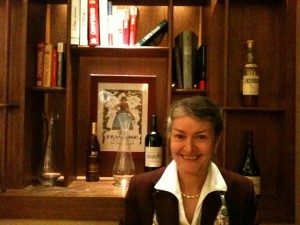 Our restaurant didn’t have a terrace with rolled-up blankets so we sat upstairs. Relationnel thought he had discovered a new venue but in fact we had eaten there once before with friends from Canberra and enjoyed it. The tables are fairly spread out but there was a lot of noise in the room next door which we weren’t too thrilled with. At one stage, two of the people came out and Relationnel immediately recognised Robert Badinter, famous in French history for having successfully abolished the death penalty on 9th October 1981. After that, we didn’t mind the noise!
Our restaurant didn’t have a terrace with rolled-up blankets so we sat upstairs. Relationnel thought he had discovered a new venue but in fact we had eaten there once before with friends from Canberra and enjoyed it. The tables are fairly spread out but there was a lot of noise in the room next door which we weren’t too thrilled with. At one stage, two of the people came out and Relationnel immediately recognised Robert Badinter, famous in French history for having successfully abolished the death penalty on 9th October 1981. After that, we didn’t mind the noise!
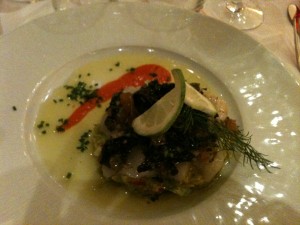 They had an excellent set menu for Valentine’s Day at 49 euros per person, starting with champagne and a little sweet pepper (piquillo) stuffed with goat’s milk cheese (very tasty). It was followed by a choice of two entrées – creamy scrambled eggs with black truffle or carpaccio of sea scallops with spicy avocado, sauce vierge (which just means olive oil) and horns of plenty (excellent) – and a choice of two main courses – grilled fillet of bass with candied lemon, creamy risotto and sea shell bouillon (which we didn’t take) or roast rack of lamb (extraordinarily tender), mutton stew gravy (sounds better in French – jus de navarin), eggplant caviar and candied tomatoes (they didn’t look very candied to me).
They had an excellent set menu for Valentine’s Day at 49 euros per person, starting with champagne and a little sweet pepper (piquillo) stuffed with goat’s milk cheese (very tasty). It was followed by a choice of two entrées – creamy scrambled eggs with black truffle or carpaccio of sea scallops with spicy avocado, sauce vierge (which just means olive oil) and horns of plenty (excellent) – and a choice of two main courses – grilled fillet of bass with candied lemon, creamy risotto and sea shell bouillon (which we didn’t take) or roast rack of lamb (extraordinarily tender), mutton stew gravy (sounds better in French – jus de navarin), eggplant caviar and candied tomatoes (they didn’t look very candied to me).
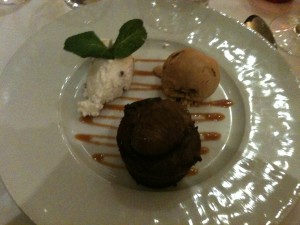 For dessert, you could have a soft-centred chocolate cake (moelleux au chocolat) with chestnuts and condensed milk ice-cream (all very tasty) or candied pineapple with lavendar honey, fiadone (a Corsican soft cheese dessert) and brown sugar biscuit ice-cream (speculoos) (Relationnel’s choice).
For dessert, you could have a soft-centred chocolate cake (moelleux au chocolat) with chestnuts and condensed milk ice-cream (all very tasty) or candied pineapple with lavendar honey, fiadone (a Corsican soft cheese dessert) and brown sugar biscuit ice-cream (speculoos) (Relationnel’s choice).
A bottle of wine per couple was also included in the menu. We could choose from two wines – a pouilly fumé sauvignon from the Loire Valley or a côtes du Rhône. We took the red, which we regretted afterwards – not because we didn’t like it, but because it was 15° !!!
As we walked past Le Comptoir on the way back to the car, we noticed that all the outside tables were taken and everyone had their blankets around their knees.
La Bastide Odéon, 7 rue Corneille, 75006 Paris, tel 01 43 26 03 65, contact@bastideodeon.com, www.bastideodeon.com, M° Odéon lines 10 and 4, RER Luxembourg, open every day.If you enjoyed this post, don’t forget to subscribe to new posts – that way you’ll get them directly on your smart phone or in your mail box! And I love to hear your comments!

